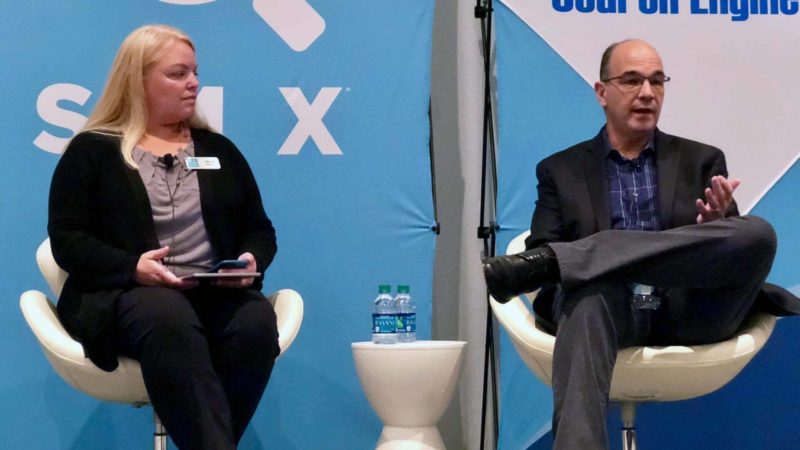
David Pann, general manager of global search business at Microsoft, and Ginny Marvin, Search Engine Land editor-in-chief, speak at SMX East.
NEW YORK — Microsoft’s eight-year process to build an AI backbone for its search platform Bing is positioning the company to innovate for the benefit of marketers, one company executive said Wednesday.
“You can’t leave it up to people because the system is changing so often,” said David Pann, general manager of global search business at Microsoft, during a keynote discussion at the SMX East event in New York City. “So what we did is we built an AI infrastructure that is really powering all the recommendations that we are putting up through our user interface or through our sales team.”
According to Pann, Bing’s AI backbone is taking in all the data from its marketplaces to learn more about things like client objectives, so that it can make automated recommendations for advertisers. But what looks like an all-machine process is actually humanized and refined by Microsoft’s sales team based on their knowledge of clients’ businesses and goals.
“So we may have hundreds of recommendations for a client that an algorithm has said ‘we should be doing one to 100,’ but our sales teams come an and say ‘interesting, but my knowledge of the customer is so good that the first five recommendations don’t make sense.’”
Ultimately, Pann said it’s about giving time back to marketers, and Microsoft is investing in new interfaces to do just that. Pann teased about an AI-driven solution called Bing Advisor designed to give insights to marketers. This may be a few years out, but is something that’s been in the works for a year or two.
Do no harm
With machine learning comes a responsibility to ensure the recommendations made by Bing’s engine are credible and ethical. For starters, according to Pann, that means democratizing AI so that it is not just in the hands of large enterprises. It also means factoring in accessibility so users with disabilities can access their intelligence.
But perhaps one of the trickiest and perhaps most essential safeguards is protecting that AI from bias.
“If there is bias in the world and you build it into your AI, then you will have a biased AI that does not understand how the diversity of our world and the diversity of our opinions can really bring the world together,” he said.
Pann pointed to lessons learned from Tay, a Microsoft chatbot launched in 2016 that was taken down after it quickly started posting racist messages.
Pann said Microsoft is already adjusting results in its news services to show different perspectives on news topics.
LinkedIn and the death of the parrot
Penn repeatedly pointed to the depth of the Microsoft graph, which includes data generated from Microsoft’s entire ecosystem, as adding a lot of power to its AI backbone. This week Bing announced that marketers would now be able to target three attributes from LinkedIn — company, job function and industry — in their search campaigns.
While the pilot is beginning with those three data points, LinkedIn captures a host of other attributes they are considering making available.
In the past, Bing Ads has acknowledged being a fast follower to Google Ads’ product updates. There’s been a shift, though. Rather than Bing parroting advancements by its chief rival Google, instead, new capabilities have given them the “right to innovate,” Pann said, pointing to the LinkedIn news as a recent example.
“This whole idea of parroting versus innovating is flip-flopped,” he said.
